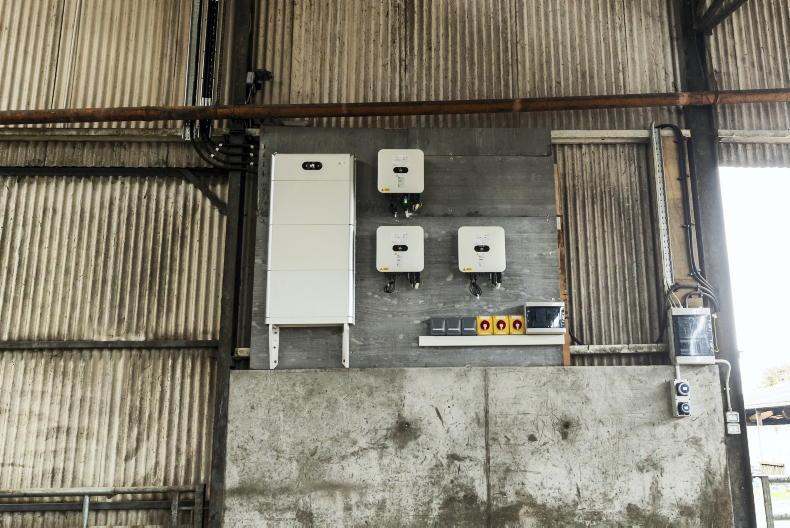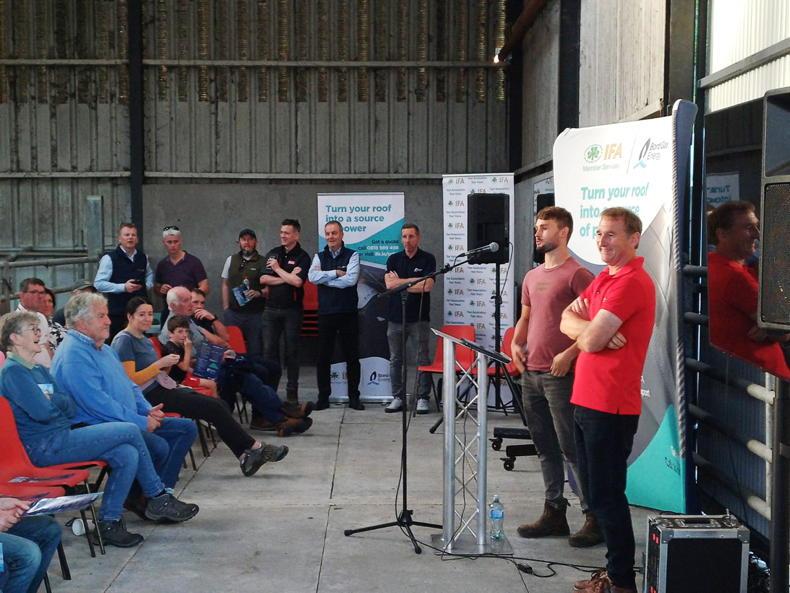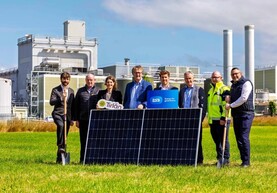In the latest of a series of events, the IFA Rooftop Solar Roadshow travelled to Longford last week, the second last stop on the tour. The events focus on promoting rooftop solar PV systems as an investment decision and have been held on farms which have already installed solar panels on their sheds.
This time, the roadshow travelled to the dairy farm of Andrew and Daniel McHugh in Longford, who installed solar panels last year. The event was attended by over 100 farmers. This article runs through the key take-homes from the meeting.

Andrew McHugh.
Solar in fashion
The meeting in Longford saw speakers from the IFA and Bord Gáis Energy, who are in a commercial partnership, and the McHughs, discuss solar PV as an option for farmers and answered questions from the audience.
Like every farm investment, it has to stack up. With solar PV grants available under TAMS and several other changes improving the business case for solar, payback periods have dropped from 12 to 13 years to just two to five years. As a result, solar is once again being seen as a viable investment for farms, particularly with the strong performance of the dairy and drystock sectors this year
McHugh’s solar decision
Andrew, who milks 200 cows with his son Daniel, explained that he had solar PV in mind for years. He had looked at other renewable energy systems over time, including anaerobic digestion, but solar seemed the most promising.
When he built his new slatted shed, he designed it with solar in mind and didn’t wire it until he was ready to install the solar PV system. However, it wasn’t until the 60% TAMS grant became available that the numbers really stacked up for him.
In 2024, he decided to install a 63 panel, 27.7kW solar PV system, along with a 20kWh battery. The system was installed in March and to comply with TAMS, he had to cover roof lights and add extra bars to the shed roof, which came at an additional cost.
His electricity demand is reasonably high. He runs a heat pump in his house, an electric car, four scrapers, as well as lights, parlour and milk cooling. His house and yard are on the same electricity meter.
Within the first 16 months, the system produced over 33 megawatt-hours of electricity, with around 90% of it used on the farm.
This high usage rate is partly thanks to the sizeable batteries Andrew installed. He could only receive a 60% grant for batteries up to half the size of the solar PV system, so he paid the rest himself.
After the grants, the system cost around €24,000. After one year of operation, the McHughs have saved €6,000 on electricity costs and expect the system to pay for itself in around four years.
Andrew’s advice to any farmer out there considering it is to get the best advice you can. It is a big investment, he said, and you should get advice to maximise it and make sure the electricity and grants are used the best they can be.

Peter Clarke.
Farmers more educated
In conversation with the Irish Farmers Journal, the IFA’s Peter Clarke said: “One thing we have noticed is that farmers have become much more educated than they were two years ago. Back then, the tone of any presentation we made was about explaining what solar is. Now, it’s much more detailed, with questions like: what’s competitive out there?, what are the connection options?, how’s the panel performance,? etc”.
“It’s a really positive sign,” he added. He said the real interest is coming from dairy farmers, but drystock farmers with the house and yard on the same meter are also very interested.
He explained, “There was a bit of fear in the beginning, which may account for the low uptake. The reality is that this is a major investment for a farmer, and you didn’t have the track record back then.”
When asked about cheaper panel systems on the market, he said, “You have to know what you’re getting, sometimes, you get what you pay for. We stand over what we do.”
The IFA is in partnership with Bord Gáis Energy, which recently acquired solar PV supplier Swyft Energy. Peter said this shows Bord Gáis’s commitment to renewables and confirmed that the IFA will continue to be the agri-facing partner for Bord Gáis on solar PV.
Peter said he is concerned about the noises being made by Government regarding potential TAMS budgets constraints. He said his understanding is that the ringfenced TAMS budget is being used up faster than expected, which could create problems for future funding.
“There’s been no real ranking criteria yet,” he said, “but there’s talk that such criteria could be introduced in the next tranche. That could mean that the farmers making the biggest impact, for example, dairy farms, may not score as highly as others”.
“It just seems like you’re introducing a barrier there that isn’t going to help,” he said.

The batteries and inverters on the McHugh farm.
On the rural network in Ireland, Peter said: “The reality is that a percentage of farmers are not getting the connections they’d like. Therefore, there is an investment required to improve that. I’d say, certainly process-wise, it seems to be improving, but we’re still a long way from facilitating every connection.”
Vat issues
Peter explained that some farmers have encountered issues when trying to claim VAT back on their solar PV systems. He first became aware of the problem when a farmer contacted him, saying his VAT return was €800 short.
When questioned by Revenue about whether he was exporting electricity, the farmer replied he was exporting 9% of it. Peter thinks Revenue then decided that this portion was to be deducted. Peter said the IFA are engaging with Revenue on this matter.
Ground v roof
A question asked on the night was about the difference between a ground-mounted system and a rooftop-mounted system. Peter explained that it would be 30%–40% more expensive to install a ground-mounted system, and anything above 75m² requires planning permission.
However, there may be advantages to ground-mounted systems when it comes to maintenance, as Peter said that solar panels benefit from being cleaned at least once a year.
Meters
A key factor in making solar stack up on livestock and tillage farms, where electricity consumption is typically low, is whether the farmhouse and yard are on the same meter.
If they are, both can be considered when sizing the system. This effectively means you’re getting a 60% grant on solar panels for your house. However, he reminded attendees that the panels must be installed on farm sheds, not on the house itself.
He also explained that the ESB is unlikely to have a three-phase smart meter available until next year. This meter is required for accurate readings when exporting electricity back to the grid. In the meantime, farmers will instead use a deemed export formula.
Lifespan
Another question on the night was about the life expectancy of the panels. Peter explained that the panels they use are JA Solar bifacial panels, a Chinese brand, which come with a 25-year replacement warranty and a 30-year performance guarantee. After 30 years, the panels should still be producing around 85% of their original output.
The battery they supply comes with a 15-year warranty, while the inverter has a 12-year warranty. A strong message throughout the evening was the importance of choosing a supplier who is likely to still be in business in the years ahead, in case anything goes wrong with the panels.
In the latest of a series of events, the IFA Rooftop Solar Roadshow travelled to Longford last week, the second last stop on the tour. The events focus on promoting rooftop solar PV systems as an investment decision and have been held on farms which have already installed solar panels on their sheds.
This time, the roadshow travelled to the dairy farm of Andrew and Daniel McHugh in Longford, who installed solar panels last year. The event was attended by over 100 farmers. This article runs through the key take-homes from the meeting.

Andrew McHugh.
Solar in fashion
The meeting in Longford saw speakers from the IFA and Bord Gáis Energy, who are in a commercial partnership, and the McHughs, discuss solar PV as an option for farmers and answered questions from the audience.
Like every farm investment, it has to stack up. With solar PV grants available under TAMS and several other changes improving the business case for solar, payback periods have dropped from 12 to 13 years to just two to five years. As a result, solar is once again being seen as a viable investment for farms, particularly with the strong performance of the dairy and drystock sectors this year
McHugh’s solar decision
Andrew, who milks 200 cows with his son Daniel, explained that he had solar PV in mind for years. He had looked at other renewable energy systems over time, including anaerobic digestion, but solar seemed the most promising.
When he built his new slatted shed, he designed it with solar in mind and didn’t wire it until he was ready to install the solar PV system. However, it wasn’t until the 60% TAMS grant became available that the numbers really stacked up for him.
In 2024, he decided to install a 63 panel, 27.7kW solar PV system, along with a 20kWh battery. The system was installed in March and to comply with TAMS, he had to cover roof lights and add extra bars to the shed roof, which came at an additional cost.
His electricity demand is reasonably high. He runs a heat pump in his house, an electric car, four scrapers, as well as lights, parlour and milk cooling. His house and yard are on the same electricity meter.
Within the first 16 months, the system produced over 33 megawatt-hours of electricity, with around 90% of it used on the farm.
This high usage rate is partly thanks to the sizeable batteries Andrew installed. He could only receive a 60% grant for batteries up to half the size of the solar PV system, so he paid the rest himself.
After the grants, the system cost around €24,000. After one year of operation, the McHughs have saved €6,000 on electricity costs and expect the system to pay for itself in around four years.
Andrew’s advice to any farmer out there considering it is to get the best advice you can. It is a big investment, he said, and you should get advice to maximise it and make sure the electricity and grants are used the best they can be.

Peter Clarke.
Farmers more educated
In conversation with the Irish Farmers Journal, the IFA’s Peter Clarke said: “One thing we have noticed is that farmers have become much more educated than they were two years ago. Back then, the tone of any presentation we made was about explaining what solar is. Now, it’s much more detailed, with questions like: what’s competitive out there?, what are the connection options?, how’s the panel performance,? etc”.
“It’s a really positive sign,” he added. He said the real interest is coming from dairy farmers, but drystock farmers with the house and yard on the same meter are also very interested.
He explained, “There was a bit of fear in the beginning, which may account for the low uptake. The reality is that this is a major investment for a farmer, and you didn’t have the track record back then.”
When asked about cheaper panel systems on the market, he said, “You have to know what you’re getting, sometimes, you get what you pay for. We stand over what we do.”
The IFA is in partnership with Bord Gáis Energy, which recently acquired solar PV supplier Swyft Energy. Peter said this shows Bord Gáis’s commitment to renewables and confirmed that the IFA will continue to be the agri-facing partner for Bord Gáis on solar PV.
Peter said he is concerned about the noises being made by Government regarding potential TAMS budgets constraints. He said his understanding is that the ringfenced TAMS budget is being used up faster than expected, which could create problems for future funding.
“There’s been no real ranking criteria yet,” he said, “but there’s talk that such criteria could be introduced in the next tranche. That could mean that the farmers making the biggest impact, for example, dairy farms, may not score as highly as others”.
“It just seems like you’re introducing a barrier there that isn’t going to help,” he said.

The batteries and inverters on the McHugh farm.
On the rural network in Ireland, Peter said: “The reality is that a percentage of farmers are not getting the connections they’d like. Therefore, there is an investment required to improve that. I’d say, certainly process-wise, it seems to be improving, but we’re still a long way from facilitating every connection.”
Vat issues
Peter explained that some farmers have encountered issues when trying to claim VAT back on their solar PV systems. He first became aware of the problem when a farmer contacted him, saying his VAT return was €800 short.
When questioned by Revenue about whether he was exporting electricity, the farmer replied he was exporting 9% of it. Peter thinks Revenue then decided that this portion was to be deducted. Peter said the IFA are engaging with Revenue on this matter.
Ground v roof
A question asked on the night was about the difference between a ground-mounted system and a rooftop-mounted system. Peter explained that it would be 30%–40% more expensive to install a ground-mounted system, and anything above 75m² requires planning permission.
However, there may be advantages to ground-mounted systems when it comes to maintenance, as Peter said that solar panels benefit from being cleaned at least once a year.
Meters
A key factor in making solar stack up on livestock and tillage farms, where electricity consumption is typically low, is whether the farmhouse and yard are on the same meter.
If they are, both can be considered when sizing the system. This effectively means you’re getting a 60% grant on solar panels for your house. However, he reminded attendees that the panels must be installed on farm sheds, not on the house itself.
He also explained that the ESB is unlikely to have a three-phase smart meter available until next year. This meter is required for accurate readings when exporting electricity back to the grid. In the meantime, farmers will instead use a deemed export formula.
Lifespan
Another question on the night was about the life expectancy of the panels. Peter explained that the panels they use are JA Solar bifacial panels, a Chinese brand, which come with a 25-year replacement warranty and a 30-year performance guarantee. After 30 years, the panels should still be producing around 85% of their original output.
The battery they supply comes with a 15-year warranty, while the inverter has a 12-year warranty. A strong message throughout the evening was the importance of choosing a supplier who is likely to still be in business in the years ahead, in case anything goes wrong with the panels.









 This is a subscriber-only article
This is a subscriber-only article










SHARING OPTIONS: